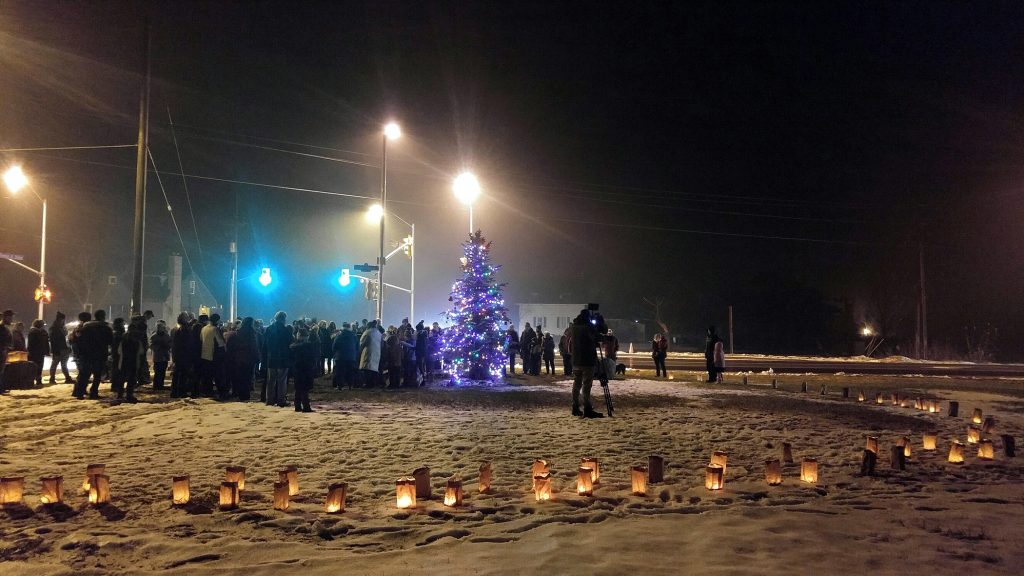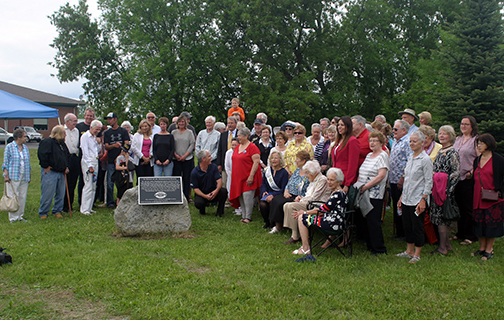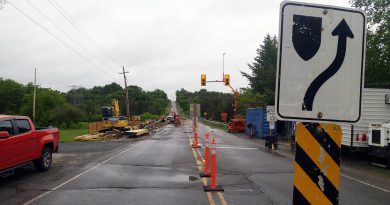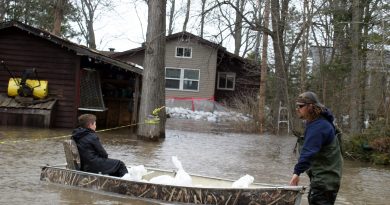Younghusband General Store history by George Kennedy
The following historical submission was written by occasional West Carleton Online contributor George Kennedy.
DUNROBIN – Ever since Younghusband’s store was demolished to straighten Dunrobin Road, I have felt that it is too bad that some of its history wasn’t recorded. Except for J. Watters, Everett Read and Leo Muldoon, I’m about the only other one around that remembers it in the ‘30s and ‘40s, before it was modernized, so I will do my best to tell you what it was like.
Most people remember it as the social meeting place of Dunrobin and during the 1930s and ‘40s it didn’t change all that much. The store was never open on Sundays. Friday night it closed at 6 p.m., but other nights it stayed open till the visiting and shopping was over and everyone went home.
I guess I should start with the gas pumps. They were at the road level at the corner of the raised platform that went across the front of the store and the house. On the start they consisted of a big high stand with two 10-gallon glass containers that had the numbers 1 to 10 plus the 1/4 gallons displayed on both sides. On each side was a three-and-a-half foot lever that was used to pump the gas into the containers from an underground tank beside the store. There was only one grade of gas in those days. While the war was on, if you brought some cans to get filled for your tractor, they would have to drop in a little pill that turned the gas purple and it was a serious offense if you got caught using it in your car. Otherwise, you would have to have some ration coupons to have it put in your car. The big heavy three-foot door into the store was counter sunk with a two-foot deep bay window on each side. The left side usually had some five and 10-pound pails of honey that on the start was supplied by the Davis’s and later on by Roy and Rae Azulay. There would also be an assortment of rubber boots for men and boys. Younghusband’s never seemed to stock leather boots just some leather-topped gum rubbers for bush work in the deep snow. Bob Vance’s store at Woodlawn had a good assortment of work boots, so we had to go there to get a pair of ‘John Palmers.’
There was a four-foot walkway down the middle of the store that led to a door into the ‘back store’ that I will tell about later.
There was a big counter about 10 feet long on each side of the walkway. I think that these would be second hand from some big store in Ottawa. The end of the one on the left started about two feet from the bay window and was out about a foot and a half from shelves along the wall. This was known as the dry goods section where the work shirts, heavy woollen sweaters, overalls, long underwear, woollen socks and insoles were kept. I don’t remember if any trousers were there or if any clothes for children were available. In the early 1930s most kids wore hand-me-downs. This made it a problem for me as I had three older sisters, but I never wore a dress as my mother was pretty handy with her foot-operated sewing machine. There was also an assortment of straw hats, heavy winter caps and an assortment of woollen mitts, leather mitts and gloves.
About two feet from the end of this counter a wall came out to the walkway to the ‘back store.’ This wall and space had coal oil lamp chimneys, as well as two types of barn lanterns and glasses to fit them, plus a roll of lamp wick to be cut into about five- or six-inch lengths. There were factory-made axe handles, axe heads and wedges and an odd time, if you were lucky, there might be some locally made hickory handles that everyone liked. On the narrow counter there was a variety of files and carborundum stones to sharpen saws and axes.
Going back to the front door again, when it was open it came to the end of the matching big long counter. The first thing on the counter was a steel dispenser for an 18-inch roll of wrapping paper. A light white cord came from a spool behind the open door and hung down from a hook in the ceiling to tie up the wrapped articles. It always amazed me how Joe and Irving could wrap the string somehow around their fingers and pull to break it without hurting their fingers. Irving was Joe’s nephew who took over the store after Joe’s death.
After about two feet of counter space was the scales that gave the weight, cost per pound, and total cost, and then the cash register. Between the cash register and the end of the big counter were two glass display cases. The first one held the chocolate bars, gum and licorice curly pipes and imitations of a plug of chewing tobacco. Part of the next case had Westclock pocket watches and jackknives, some cheap knives for boys, and a few ‘Joseph Rogers’ ones for the men. This was also where the fishing supplies were kept. A reel of heavy green line was there, cut to whatever length you wanted, usually 12 to 14 feet, depending on the length of the pole you cut on the side of the road and the depth of the fishing hole. There were three different sizes of hooks; the middle-sized ones were best for mudpouts. There were three different weights of sinkers, but we usually used an old rusty nut from the toolbox of the grain binder that was the same weight. Later there were red celluloid bobbers, but it was easy to cut a short piece off a dead branch where you cut your fishing pole which did the same job.
The other end of the case held an assortment of spools of thread of different weight and colour as well as sewing needles of different sizes. There were probably other things as well, but I guess I wasn’t interested.
In the bay window on the right-hand side you might see a big stock of bananas hanging from the ceiling and wooden cases of prunes or raisins. From time to time, you might see oranges, lemons or a basket of apples in season.
The wall from here back to the post office had a narrow counter and shelves from there to the ceiling. Every kind of tobacco from Shag to Old Chum, Pic-a-Pack and Worlds Navy pipe tobacco and a few choices of fine cut tobacco to roll your own as well as five or six choices of tailor-mades were available. Chewing tobacco came in plug form, about three inches square and half an inch thick; Big Ben, Club and Dixie were the most common kinds.
On the upper shelves would be canned goods and spices, with the Cornflakes, Shredded Wheat and Puffed Wheat above. Most of us used rolled oats that came in bulk. Black tea was in about one-pound packages, but green tea that most people used came in bulk, in big tin boxes and sold in paper bags by the pound. It was unavailable when the war was on and was never sold in bulk again.
Between the end of the big counter and the post office was the Coke Cooler with the water cooled with ice from the icehouse on the start. Coca Cola, Orange Crush and Ginger Ale were the first ones, with Pepsi Cola and others coming later. Drinks and chocolate bars cost five cents, as well as a small scoop of humbugs or jelly beans in little paper bags.
On the counter and wall next to the post office were the school supplies. There was an assortment of scribblers, depending on whether a lead pencil or pen and ink was used, two-ring loose leaf note binders with paper to match as well as lead pencils, crayons, straight pens, boxes of nibs to fit them, and a few fountain pens for students past Grade 5, which was Jr. third, till 1936. There were also 12-inch rulers, two choices of erasers and small bottles of ink for home use. The schools supplied the ink at school.
The post office was a five-by-eight-foot cubicle along the outside wall, opposite the door into the living quarters. The door on the end next to the coke cooler was in two parts with a ledge on the top of the bottom part. Here people bought their stamps or picked up their mail. There was a small window next the alleyway where Myrtle Younghusband, the Post Mistress, Joe’s sister, passed the sorted mail out to the mail men for the Number 1 and 2 routes. The mail came out from Ottawa to South March on the 8 a.m. train and for years Gerald Gow brought it in to Dunrobin and took back the out-going mail to go back to Ottawa on the 3 p.m. train. Presently, it takes about four days for a letter to get there. In some ways the old days were better! Till about 1946-1947, stamps for letters were five cents and Christmas cards were one cent.
Past the post office there was quite a collection of things. Bags of bulk sugar, fine salt, rolled oats, white beans and white flour were kept there. About four feet down the wall from the post office was a big window, and past that was the big iron safe. On the end wall was a black cabinet that held three or four swinging doors with a lot of spring-type wire clips to hold the invoices for people who didn’t have the money when the articles were purchased. Quite often people would have to wait till the milk cheque came in, or they sold some cattle or pigs. This was known as the ‘McCaskey Cabinet.’ Like most store keepers in the depression years, the Younghusband’s extended credit to a lot of people, and a few would have to be written off.
I couldn’t begin to name all of the other stuff in this section. There was always putty, a few quarts of paint and varnish and paint charts to order different colours or amounts from Ottawa Paint Works, as well as an assortment of brushes.
Between the window and the safe was where they kept the bread. On the start it came down twice a week from a bake shop at Carp. It came as four loaves attached together in the form of a square and was know as a ‘pan’ of bread. Most people would take two loaves which would be broken off, taken to the front counter where it would be wrapped in the wrapping paper and tied with the string. This was what you got when you asked the clerk for half a pan of bread. In the 1940s, Morrison Lamothe supplied the bread and even some cakes and donuts.
In those times most farmers had a flock of free ranging hens, and once or twice a week they would bring whatever eggs that were more than they needed to the store. They had to be ‘candled’ and placed in special crates with 100 per layer. The candling apparatus was a tin box with a lighted candle at one end and a place to put your eye at the other. When an egg was placed in the middle you could tell if there were any blood spots or other problems. The people who only brought in eggs every two weeks were the ones they had to look closely at. Once or twice a week a man would come and take them to Ottawa.
There was a big heavy table in the middle of this section with a meat slicer and a big knife and wax paper at it. When the first customer to ask for some bologna, pea-meal roll, bacon or cheese, Joe or Irving would go out to the ‘cool’ room attached to the back store, bring it in and cut off the required amount. Usually, some other customer would see it and want some, too. Otherwise, it would be taken back out to the ‘cool’ room.
The meat or cheese would then be wrapped in wax paper, taken to the front counter, weighed, and wrapped again in the wrapping paper.
The so-called ‘cool’ room was built onto the north corner of the ‘back store.’ It had an insulated door and was about 10 feet square, surrounded by the ice house that was up against the outside wall of the back store. It had a roof over it, and with the ice covered with sawdust it would keep the ‘cool’ room cool all summer. Some of the ice was used for the ice box in the house as well as a bit for the coke cooler.
There were many other things in this part, but I will now try to tell of some of the things in the ‘back store.’ You had to go down three or four steps as it was on road level, with a door opening out onto the Town Line, or what is now the Thomas A. Dolan Parkway. The first thing on the right was a big 45-gallon drum of molasses. People would bring their own container, usually a half gallon sealer, which wouldn’t take long to fill in summertime, but quite a bit longer in winter, as this part wasn’t heated. A few times when they went to do something else while waiting for the jar to fill, they would come back to find it had over-flowed onto the floor. Such a mess!
Next to the molasses was a wooden keg of vinegar. The ‘bung’ would be knocked out and a ‘spigot’ driven in to fill whatever container the customer brought. Between here and the door was a big square tank, about 50 gallons with a hand pump on it for coal-oil. People would bring their one- or two-gallon cans, to take home for their lamps and lanterns. On the other side of the door was where the 100-lb bags of coarse salt were kept. Besides being given to the livestock, it was used in the barrels of salt pork. We always bought a bag at a time but people who didn’t have many livestock or pork to cure could bring their own containers and get it weighed out on a set of platform scales that were also needed to weigh up crushed oyster shells that were in the next bag. I don’t think oyster shells are given to hens anymore, for the shells now are pretty thin.
Not too far from the door were some 80-rod rolls of barbed wire. In case you don’t know, a rod equals 18 ½ feet. There would also be #9 stay wire, but page wire you had to order in or go to Carp Flour Mills.
There was an assortment of pails: stainless steel strainer and milk pails, and three or four sizes of galvanized pails including big ones for horses. They also kept screened nose covers to keep the nose flies away from the horses. We never had a problem at our place, but on the clay land along Dunrobin Road, there would be no need to go to the hay field without them as the horses tried to get their nose into their mate’s mane to keep the flies away.
There was a rack in the middle of the room that displayed the different forks and shovels that farmers needed, as well as some brooms and mops. Kegs with nails of all lengths from shingle nails to six-inch spikes would be put into paper bags or empty boxes and weighed on the platform scales. The same with fence steeples.
There was an assortment of lengths and sizes of bolts. On the start all the nuts were square, as that was what was on new corn binders or disk-harrows and these would have a toolbox with open-end wrenches to fit any nut. Close by would be pails of cup grease for older disk-harrows and seed drills, gun grease for the newer models.
I forgot to mention the binder twine close to the outside door. At harvest time, it came from Brantford in heavy paper bags secured with a cheap twine rope. There were six balls of twine in each bag and if you got the last three or four balls, you got the rope, too. It really wasn’t much of a treasure but would do to tie an old quiet horse.
The other thing worth mentioning was a big three-foot square board that was marked with lines an inch apart both ways, and a big T-square. They usually bought three-foot square sheets of glass and hoped that the size of the panes that the customer wanted could be cut without too much waste. They used a special steel tool about the size of a pencil with a really sharp little wheel on the end of it. With the T-square held solidly at the right place, they would press hard on the wee tool as they marked beside it. Then they would move the big pane out past the edge of the board where it could be broken off.

I should have mentioned earlier that in 1936 Joe and Ada Davis from Woodlawn were married. Ada was involved with the community right from the start. She played the organ quite often in the Anglican Church, was a hardworking member of the Dunrobin Women’s Institute, and was secretary-treasurer of the Dunrobin Gold Medal Cheese Factory till it closed in 1952.
The Younghusbands were always on for change and new ideas. In 1940 they installed a Delco set-up in a little building that had been their garage. This gave them electric lights, but they still needed the icehouse for the ‘cool’ room. In 1942 Ontario Hydro came to Dunrobin, partly through politics, but supposedly to get power to the cheese factory to help with the war effort. With electricity they could offer a bigger list of meat and vegetables and do away with the icehouse.
In 1946 Irving and his wife Edna built a cold storage locker plant. This meant that when farmers killed their own animals, they could bring them here to be quartered up, frozen, and put into big drawers. Each drawer came with a lock and a key, but almost everyone left their key on a big board inside the front door. This meant we didn’t have to eat so much salt pork, and so the pork barrel became history to tell your grandkids about.
Change was coming ‘oftener and quicker’ all the time. More meats and vegetables were available and eventually a cooking section for cakes, pies, and buns. The need for binder twine and strainer pails was gone. The store was finally sold in 1978. It had been in the Younghusband name since 1861. When the plaza was opened in 1988, Charlie Delahunt, who was married to Ellen Younghusband, the daughter of Irving and Edna, along with his two daughters, Cindy and Julie, operated the meat and grocery section. Banfield Younghusband, Ellen’s brother wasn’t keen on being a storekeeper and went through university and completed his PhD in Microbiology in Australia (West Carleton Online spoke to Ban Younghusband on June 13, 2018 as the Dunrobin WI celebrated 100 years). He is now a retired university professor living with his wife, Linda, in Newfoundland. Their two sons work for CBC television.
There are two more stories about the store that should be told. In the mid 1930s Chief McCarthy was the one-man police force for Carleton County. He had a summer cottage near Horseshoe Bay, not far from ours. My dad knew him fairly well. One Monday morning on his way to Ottawa, he called in and parked his police car by the platform in front of the store and came in for cigarettes or something. The store was full of farmers who had brought their milk to the cheese factory. All of a sudden there was an obvious exodus of farmers out through the back door to move their old Chevs or Model T Ford trucks with the factory cans, in behind Younghusband’s barn, or over to Harry Kennedy’s yard across the road, as very few had licence plates. Dad could see Chief McCarthy grinning for he had no intention of laying any charges. My dad and Uncle Harold took turns year about to buy a licence, which was traded back and forth to whoever wanted to take grist to be ground at Carp.
The other story was one time at some type of store-keepers convention, Joe was in a round table discussion on how they handled their ‘collectables’. When it came to Joe’s turn he said when the bill was getting too big, he would cut it in half. Then if they still didn’t pay, he only felt half as bad. I’m sure that in the worst of the depression this happened a lot of times.
For some reason, the city can’t designate the lot where the store used to be as a park, but the Dunrobin Women’s Institute and the Community Association have done a wonderful job of making it look like one. It started with a spruce tree that they had coloured lights on with ‘borrowed’ electricity and people gathered around it for a while on Christmas Eve to sing Christmas carols. Then they got permission to place a big stone with a plaque on it with a brief history of the Younghusband Family, as well as two benches – one donated by Banfield and his sister, Ellen’s children, Julie, Cindy and Jeff, and the other by a member of the Women’s Institute, Juanita Snelgrove, who was over 102 years old at the time. There is also a flower bed there now, looked after by WI members. I didn’t want to distract from all of this, but I got permission from the city to erect the Dunrobin Bridge sign at one corner of the lot and two hitching posts in memory of the days when the customers would tie their horses there while shopping.
I hope people will find this interesting. It has been fun putting it together.













Totally delightful! Thank you so much,Mr Kennedy, for having written this lovely account of days gone by.
Thanks to George Kennedy for the great story about Younghusband’s store! And his other stories.
Was it members of the same family who built houses in the west end of Ottawa near the Civic Hospital in the later ’40’s and 50s? Our house then was in that area and that was the name of the builder.
Sandy Bickerstaff
What an interesting and informative history of Younghusband’s stoee and surroundings. Thank you Mr. Kennedy.